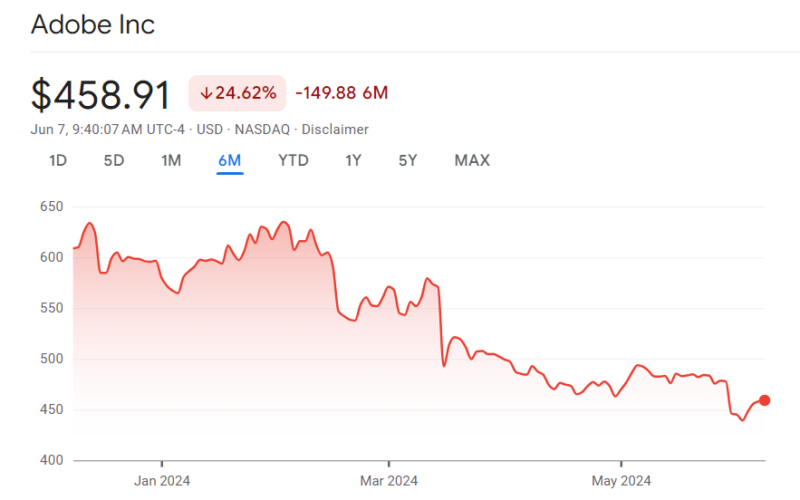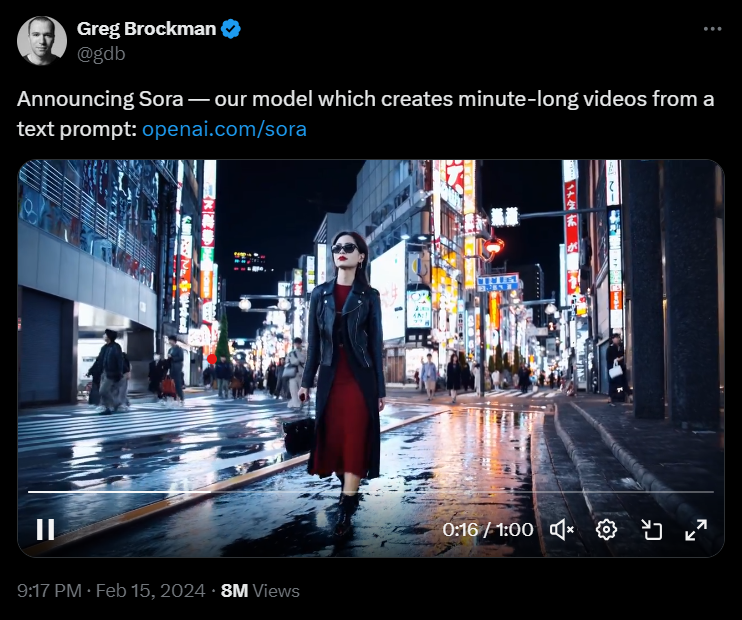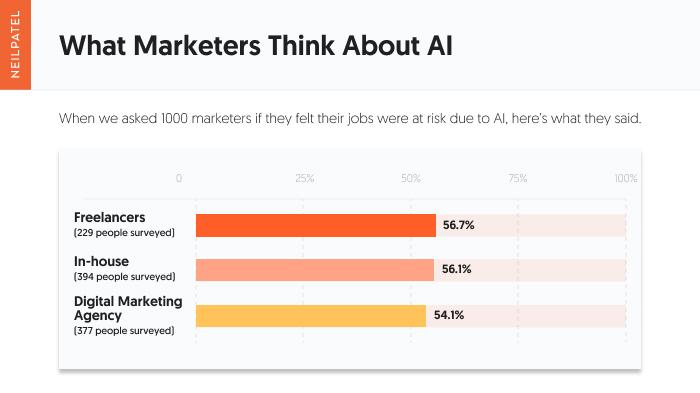Sora AI, OpenAI’s newest AI model, is staged to change the marketing and business worlds, at least as far as video production is concerned. This AI breaks the mould even further of what we thought AI tools were capable of, being able to create realistic and imaginative video content for marketing from scratch.
Adobe, one of the biggest providers of videography applications and software, recently lost $18 billion in market capital after the debut of Sora’s true capacities.

Although there’s a lot of current excitement about AI, including Sora, its true long-term effects are probably even more significant than we think.
The Transformative Impact of Sora on Marketing and Business
As of writing this, the video generator, Sora AI, is not officially available for public use, but it is anticipated that it will become available some time in the second half of 2024. With that said, we can hypothesize many of the ways Sora will be used as the next breakthrough marketing tool.
Sora AI’s text to video function allows users to create multiple shots within a single video, providing a seamless way to depict complex scenes. This includes the ability to create multiple characters and generate imaginative scenes from an existing still image or existing video.
For instance, marketers can use Sora to generate a short film featuring a short fluffy monster interacting with sea creatures in a Tokyo street setting, all based on text input prompts:

Sora’s main functions is in creating video from text by using highly descriptive prompts to ensure accurate details are captured. The diffusion model and transformer architecture behind Sora allow for the generation of many frames per second, making the animations smooth and lifelike.
However, it’s crucial to be aware of the potential for physically implausible motion and missing frames, which require human oversight to correct. Even with that, the content Sora AI has been able to produce so far has seemed pretty crisp.
Here’s the debut video showcasing the visuals Sora was able to produce, unadjusted, from a single user’s text instructions:
Sora by OpenAI is changing how we create content in marketing. A key feature is its ability to create one-minute videos from simple text prompts, which will make it super easy to create video assets for marketing purposes. This makes it much easier for marketers to quickly produce video content.
But as intriguing as this all sounds, there is no shortage of challenges either. AI-generated content can be produced in large quantities, but it may not always engage audiences as well as content made by humans. Engaging with people on social media often needs a personal touch that AI hasn’t fully mastered yet.
Here are some tips for marketers who want to use Sora AI effectively, when it becomes available:
- Try different kinds of content to find out what your audience likes best. Experiment with various formats, such as short videos, animated infographics, and interactive posts, to see which type resonates most with your target audience. This approach helps in identifying the most effective ways to capture attention and drive engagement.
- Keep improving your prompts to make the AI content better and more relevant. Continuously refine the text instructions you provide to Sora AI to generate videos. This ongoing optimization ensures that the AI produces content that aligns closely with your marketing goals and maintains high visual style and quality.
- Mix AI-generated content with human editing to make it more authentic and engaging. Combining the efficiency of artificial intelligence with the creative professionals can result in content that is both high-quality and emotionally engaging. This hybrid approach leverages the strengths of both AI and human creativity to produce videos at scale and with a high level of visual quality:
Key Takeaway: Sora is changing marketing with its ability to convert text to video, but it’s most effective when used together with human creativity.
Economic and Employment Implications
Sora AI is changing not only the way content is created but also the job market. While automation is taking over some traditional marketing roles, new jobs are appearing, especially in AI management and enhancement.
It’s essential to keep a balance between technology and human creativity. Although AI like Sora can automate many tasks, the unique insights and creative ideas of humans are still vital in developing effective marketing strategies.
Much like all other types of AI, Sora will likely have a lasting impact on jobs down the line. And while that may mean jobs that exist now may not exist later, there will likely be a new influx of roles related to AI prompt engineering.
Let’s take a glance at what business owners can do to prepare the roles in their company for more comprehensive AI use:
1) Figure out which jobs AI can improve, not just replace
The painful truth is that many of the job functions marketers are doing today will partially if not completely be replaced by AI, but that doesn’t mean that an entire career in marketing is undone just like that. This is where we pivot out expertise and focus on wielding AI to do hat we used to do manually.
Identify roles where AI can enhance efficiency and productivity without eliminating the need for human oversight. For instance, AI can handle data analysis and routine tasks, allowing humans to focus on creative and strategic initiatives.
If you assess the specific functions within your organization, you can pinpoint critical areas where AI can support and augment human capabilities. This might include automating repetitive tasks such as report generation or customer inquiries, which frees up employees to engage in more complex problem-solving and innovation.
Most importantly, you should approach AI implementation with the goal of complementing human effort, thereby creating a more dynamic and productive work environment:

2) Provide training for your team to use AI tools efficiently
Equip your workforce with the necessary skills to operate and integrate automated tools like Sora AI into their workflows. Continuous education and training programs ensure that employees stay up-to-date with the latest AI advancements and can leverage these tools to their full potential.
Offering workshops, online courses, and hands-on training sessions can help employees become comfortable and proficient in using AI technologies. Additionally, creating a culture of continuous learning and adaptation will encourage your team to embrace new tools and methodologies, ultimately leading to greater efficiency and innovation in their daily tasks.
3) Develop new job roles that require AI manipulation skills
Create positions specifically tailored to the management and enhancement of AI systems. These roles might include AI specialists, data scientists, and AI ethics officers who ensure the responsible use of AI in marketing strategies. Developing these roles requires a focus on attracting and retaining talent with the technical expertise to manage and improve AI applications.
AI specialists can oversee the deployment and maintenance of AI systems, while data scientists can analyze and interpret the vast amounts of data processed by these systems to inform strategic decisions. AI ethics officers, on the other hand, play a crucial role in ensuring that AI use aligns with ethical standards and best practices, safeguarding against potential misuse and bias.
Key Takeaway: While tools like Sora AI are changing marketing roles, there is still a growing need for human creativity and strategic management.
Business Strategy and Competitive Dynamics
Sora is changing the way companies think about competition. Large businesses with more resources can use AI tools like Sora more effectively than smaller ones.
This shift in technology is making all companies, regardless of size, rethink their strategies. They are adopting AI to remain competitive and innovative in a fast-evolving market.
To help you understand these changes, here are some practical steps:
- Evaluate how your business can adopt AI tools like Sora. Conduct a thorough assessment to identify positive areas where AI can enhance efficiency and innovation within your organization. This evaluation should consider the specific needs of your business and how AI can address them effectively.
- Look for partnerships with AI providers to boost your operations. Collaborate with established artificial intelligence providers to leverage their expertise and technology. These partnerships can provide access to advanced AI tools and support, helping your business integrate AI solutions more seamlessly and effectively.
- Regularly train your employees to use AI in their daily tasks. Implement ongoing training programs to ensure your workforce is proficient in using AI tools like Sora. Regular training helps employees stay updated with the latest AI developments and utilize these tools to optimize their workflows and enhance productivity.
Key Takeaway: Sora is not just a tool for innovation but a driver of strategic business changes.
Final Word on Sora’s Role in Marketing and Business
Sora by OpenAI has changed the way businesses create content and plan for the future. Its influence extends from video production to changing job roles.
As you adjust to these shifts, it’s important to balance the use of AI like Sora with the need for human creativity. Staying updated and adaptable will help you succeed in this evolving AI-enhanced environment.
Related Video
If you’re ready to level up your digital marketing with AI, Single Grain’s AI marketing experts can help!👇
For more insights and lessons about marketing, check out our Marketing School podcast on YouTube.



